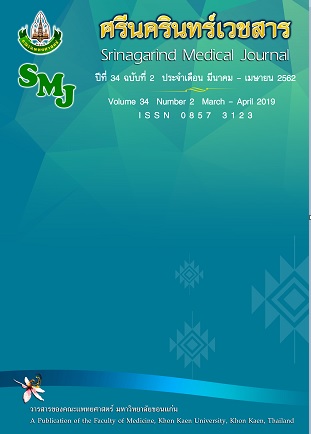Effect of Manual Hyperinflation Technique with Suction on Heart Rate and Blood Pressure in Paediatric Patients receiving Mechanical Ventilation
Keywords:
Manual hyperinflation; Heart rate; Blood pressure; Pediatric; Mechanical ventilationAbstract
Background and Objective: Manual hyperinflation (MH) technique enhances gas exchange, increase lung compliance, reduce airway resistance, improve lung atelectasis and secretion clearance. However, there is no study about the effects of MH with suction on the circulatory system parameters in paediatric patients with mechanical ventilation. The aims of this study were to compare the effect of MH with suction on the heart rate (HR) and blood pressure (BP) in paediatric patients with mechanical ventilator.
Methods: Twelve pediatric patients with mechanical ventilator admitted at the Pediatric Intensive Care Unit (PICU), Lampang Hospital were studied. Eligible patients randomly received intervention with either (1) MH and suction in morning followed by suction in afternoon, or (2) suction in morning followed by the MH and suction in afternoon, separated by 4 hours for wash-out period. The parameters (HR and BP) were recorded from the patient's bedside monitor display during before and the end of intervention and immediately at 5, 10, 15, 20, 25 and 30 minutes, respectively. Repeated ANOVA with Bonferroni post hoc analysis were used to analysis the parameters. Statistical significance was p<0.05.
Result: The results demonstrated that the HR and BP prior to intervention and at the various time points after the intervention were similar for both interventions (p>0.05). No adverse events during or after MH were noted for any of the patients during this study.
Conclusion: MH with suction had no effect to HR and BP in pediatric patients.
References
2. Paul SP, Wilkinson R, Routley C. Management of respiratory tract infections in children. Nursing: Research and Reviews 2014; 4: 135-48.
3. Hawkins E, Jones A. What is the role of the physiotherapist in paediatric intensive care units? A systematic review of the evidence for respiratory and rehabilitation interventions for mechanically ventilated patients. Physiotherapy 2015; 101: 303-9.
4. Oberwaldner B. Physiotherapy for airway clearance in paediatrics. Eur Respir J 2000; 15: 196-204.
5. De Boeck K, Vermeulen F, Vreys M, Moens M, Proesmans M. Airway clearance techniques to treat acute respiratory disorders in previously healthy children: where is the evidence? Eur J Pediatr 2008; 167: 607-12.
6. McCord J, Krull N, Kraiker J, Ryan R, Duczeminski E, Hassall A, et al. Cardiopulmonary physical therapy practice in the paediatric intensive care unit. Physiother Can 2013; 65: 374-7.
7. Berney S, Haines K, Denehy L. Physiotherapy in critical care in australia. Cardiopulm Phys Ther J 2012; 23: 19-25.
8. De Godoy VC, Zanetti NM, Johnston C. Manual hyperinflation in airway clearance in pediatric patients: a systematic review. Rev Bras Ter Intensiva 2013; 25: 258-62.
9. Prasad SA, Main E. Paediatrics. In: Pryor JA, Prasad SA, eds. Physiotherapy for Respiratory and Cardiac Problems. China: Elsevier; 2009: 336.
10. Prasad Sa, Hussey J. Peadiatric respiratory care: a guide for physiotherapists and health professionals. London: Chapman and Hall; 1995: 78-80.
11. Berti, JS, Tonon E, Ronchi CF, Berti HW, Stefano LM, Gut AL, et al. Manual hyperinflation combined with expiratory rib cage compression for reduction of length of ICU stay in critically ill patients on mechanical ventilation. J Bras Pneumol 2012; 38: 477-86.
12. Cunha MT VN, Corte L, Cristianni R, Martins SR, Corte L. Impacto hemodinâmico e respiratório da técnica da hiperinsuflação manual em crianças sob ventilação mecânica. Pediatria (São Paulo) 2008; 30: 15-21.
13. Singer M, Vermaat J, Hall G, Latter G, Patel M. Hemodynamic effects of manual hyperinflation in critically ill mechanically ventilated patients. Chest 1994; 106: 1182-7.
14. Johnston C, Zanetti NM, Comaru T, Ribeiro SN, Andrade LB, Santos SL. I Brazilian guidelines for respiratory physiotherapy in pediatric and neonatal intensive care units. Rev Bras Ter Intensiva 2012; 24: 119-29.




